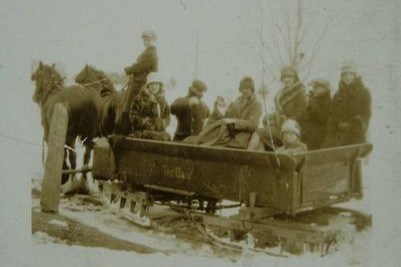The next time it snows and you grumble about the time it takes for the plows to clear your street, think back to the olden days… For decades, locally, horse-drawn sleighs and cutters remained the vehicles of choice in winter, even after automobiles were introduced. Lorne West noted that early in the 1900s, “not many farmers had a car, and those who did couldn’t use them in the winter because the roads were filled with snow from fence to fence.” As late at the 1940s, winter mail delivery in West Gwillimbury Rural Route 1 was by horse and cutter.
Horses got kids to school and families to church. “In the winter, Dad hitched up the horses to the sleigh. He had a grain wagon box, which he put on the sleigh with boards across it for us to sit on. We all sat in rows dressed in knitted toques, scarves and mitts, long black stockings over shoes with a black pair of rubbers, and long warm coats, with underwear made of white flannelette. Bricks were warmed in the wood stove oven then wrapped up to keep us warm.” – Frances Kneeshaw.
The township did have snow clearing equipment, but roads could still become impassable. In February and March of 1945, so much snow fell that huge snowdrifts blocked the roads. The township had to hire a bulldozer to break through the drifts.
Doris (Wright) Sutherland was a teacher at the one-room S.S. #4 schoolhouse in the Scotch Settlement, from 1944 to 1947. When a huge snowstorm blew in one March afternoon, “visibility quickly became nil and local parents arrived immediately to pick up their children. Others from across the marsh didn’t arrive, and I wouldn’t consider allowing the children to leave by themselves. Consequently, seven of us were there for the ‘duration.’ Fortunately, we had hot lunch supplies so we did not go hungry. We played games, sang songs, etc. until bedtime. We doubled seats together to make a makeshift bed and huddled under our coats. I stoked the wood furnace every few hours and morning finally arrived. When the parents appeared for their children, the kids were so reluctant to leave — they thought that they had had a great time.”
Some snow was so deep it reached rooftops in Bradford. One major storm occurred in April 1975, when more than 0.3 metres of snow fell, and strong winds pushed the snow into towering 4.5-metre drifts, blocking roads and leading to numerous collisions. In Bond Head, about 175 people were stranded, taking shelter in the Bond Head Community Hall for days, where they were fed by local families. Schools were closed. Some vehicles, abandoned in the snow, had to be pushed off the road before the plows could get through.
“Those weather conditions were very common during the 1940s and 50s. I often remember playing on the snow banks and being able to touch the telephone wires.” – Leila Lloyd.
From Governor Simcoe Slept Here: The Legacy of West Gwillimbury, and Bradford West Gwillimbury Public Library Archives.
Do you have a little-known fact about Bradford West Gwillimbury’s history? Email the details to [email protected].




